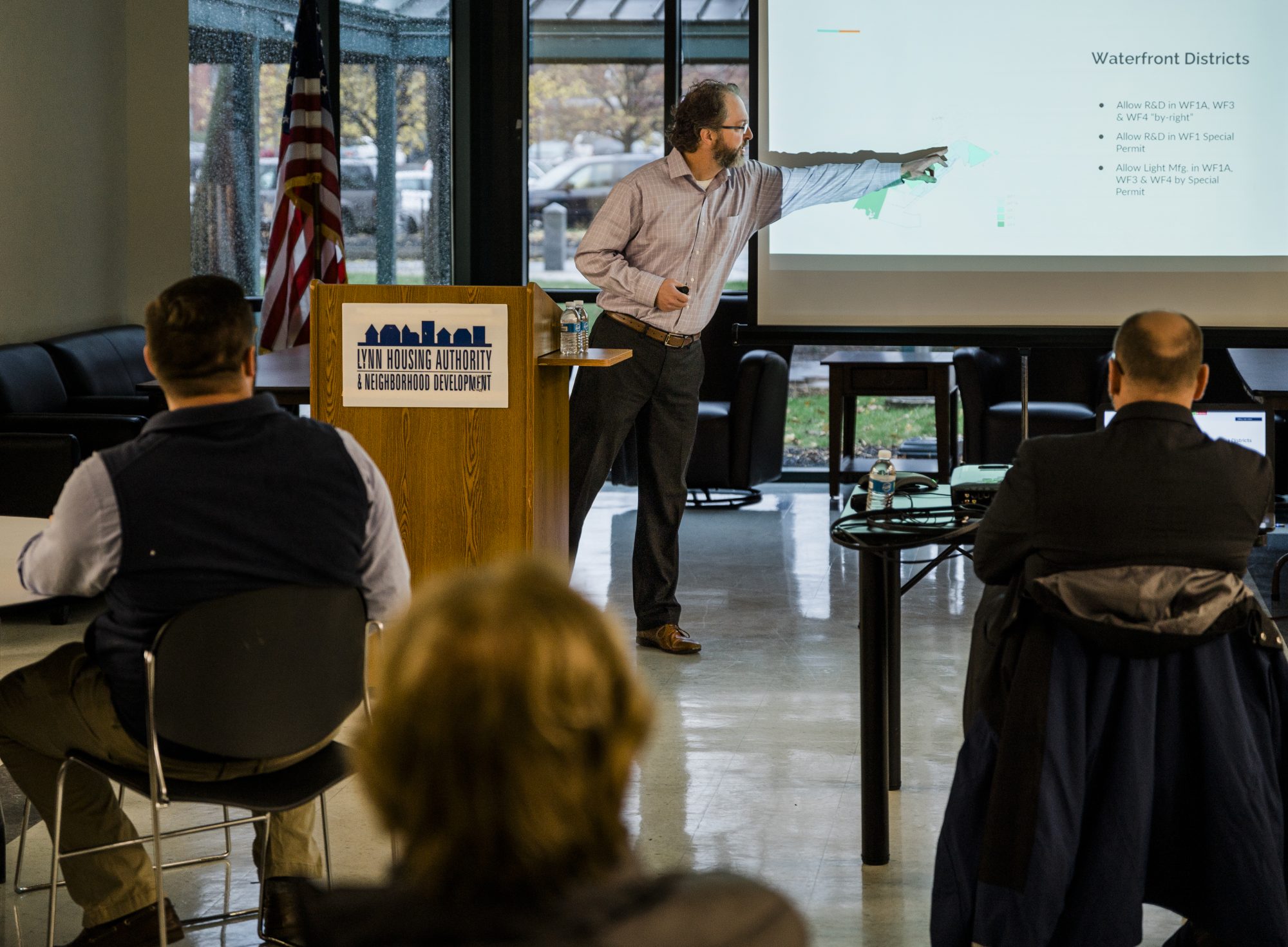LYNN — Mayor Jared Nicholson and Principal Planner Aaron Clausen presented the city’s proposed zoning ordinance before the Greater Lynn Chamber of Commerce Wednesday morning at the Lynn Housing Authority and Neighborhood Development Headquarters.
The proposed ordinance, which city council and the planning board will discuss before a public hearing Tuesday, Dec. 13, would require 10 percent of any new residential development to meet a 60 percent Area Median Income affordable housing requirement. It also aims to alter industrial and commercial zoning restrictions with the goal of supporting economic growth along the waterfront and in the downtown area.
Welcoming chamber of commerce members, Nicholson provided an overview of the ordinance, which he said intends to support financial growth, and ensure, through affordable housing mandates, the city grows in an inclusive way.
“The main point I want to make here is that this is about delivering on the administration’s top priority of inclusive growth. There’s a lot in this proposal that is about encouraging commercial and industrial growth,” Nicholson said. “One of the assets that we are bringing to these companies, encouraging them to invest here is not just the products that we have here, but the people and the workplace. That’s a tough issue for a lot of companies, and so having affordable places for our residents to live is really going to help us with that.”
In September, the Economic Development and Industrial Corporation (EDIC) of Lynn hosted a trolley tour where city officials presented life science companies with potential lots of land to set up shop. Clausen said Wednesday morning that the city aims, through the proposed ordinance, to align its zoning to pave the way for life sciences companies and small manufacturing businesses.
“It’s growing a broader range of job opportunities for folks living near the city, and then preserving land that is currently zoned for industrial and commercial uses for those purposes instead of allowing multifamily residential in those districts,” Clausen said.
Part of the push toward industrial and commercial use zoning on the waterfront, Clausen said, was to eliminate multifamily use by-right option in the waterfront district, and including permit options for open floor planning, allowing for small manufacturing companies, such as microbreweries and wineries, to have ground floor retail spaces. By zoning for ground floor retail manufacturing, Clausen said that Lynn can create a walkable waterfront area similar to that of Kendall Square in Cambridge.
“We’re really focusing redevelopment that has residential to have ground floor retail travel commercial uses to ensure that we’re creating a walkable, vibrant neighborhood,” he said.
Currently, waterfront districts in Lynn have a 30 to 35 percent open space requirement, which, Clausen said, is consistent with zoning requirements typical for a suburban town, not a growing city. The proposed ordinance, he said, would lower the minimum open space requirement to 10 percent.
“The minimum of 35 percent for most of the waterfront districts, 30 percent for the waterfront, that is a very suburban sort of dimensional requirement. It’s not what we would see in a more urban environment, such as what we’re trying to drive here. We’re eliminating that 35 percent minimum and reducing it down to 10 percent, to allow more floor area to support more growth in those districts,” he said.
When Clausen presented the ordinance’s inclusionary zoning side, explaining that in-lieu of affordable housing, developers can opt to make payments to the city’s Affordable Housing Trust, real estate broker Ryan Newhall asked how a growing city would impact public safety, crowded schools, and the sewage system.
“With all these zoning changes, all these added units, I believe the sewer treatment plant is already at capacity, as well as other conversations with public safety about the changing landscape of what they need in schools, how would you handle that?” Newhall asked.
Nicholson responded that the discussion on inclusionary zoning should not be confused with the city’s growth overall. He added that the city will grow with or without inclusionary zoning, and that the city is working to create spaces for education.
“We’re talking about inclusionary zoning, we’re not talking about changing the number of units that are coming. We’re expecting residential growth to happen —It’s been happening. This inclusionary zoning doesn’t ask how many units, it asks how many of those will be affordable for Lynn residents,” Nicholson said.
In what he referred to as a “curveball question,” Greater Lynn Chamber of Commerce Executive Director Colin Codner asked EDIC Director Jim Cowdell how he saw the proposed ordinance impacting economic growth from his perspective. Cowdell replied that on the affordable housing side of the ordinance, almost every city in the state has an inclusionary zoning ordinance of some sort, and that in terms of economic growth, the proposed ordinance would bring jobs to the city.
“On the economic development side, I think it’s a no brainer, we’re taking character witnesses, when we had that developers tour, we had 70 people come because of the activity that’s here. We want life sciences, we want other companies, we need jobs,” Cowdell said. “It makes it easier for companies to locate here. To me, it’s a no brainer. I Support both sides of this ordinance, I think it’s a good step forward.”

